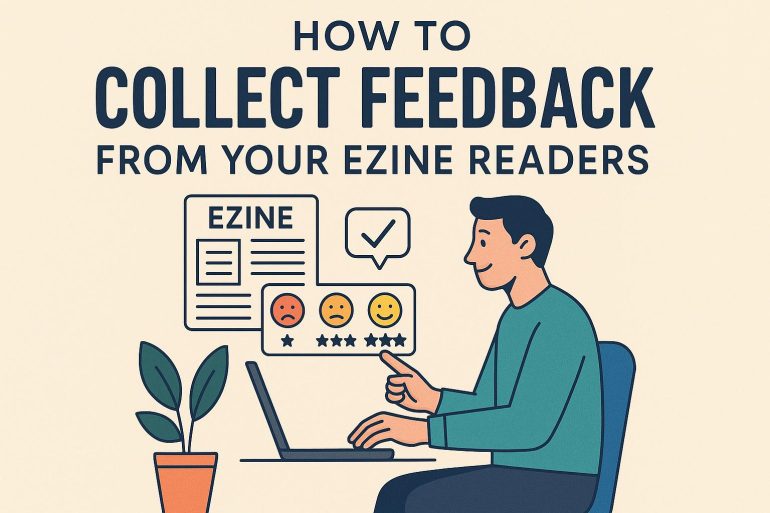Importance of Collecting Feedback from Your Ezine Readers
Understanding the preferences and needs of your audience is pivotal to creating engaging and effective content. One of the most profound ways to gain this understanding is through the collection of feedback from your ezine readers. By examining the thoughts, concerns, and suggestions of those who engage with your digital publication, you can improve the quality, relevance, and impact of your content. Such feedback serves as a guiding star for making editorial choices, allowing you to finely tune your content strategy to suit the evolving demands and interests of your readership.
Feedback from readers provides an extensive range of insights that can highlight both the strengths of your content and areas in need of enhancement. When an ezine consistently receives and integrates reader feedback, it can achieve a higher level of alignment with audience interests, thus boosting reader satisfaction and loyalty.
Methods for Gathering Feedback
Collecting feedback is a multi-faceted process that incorporates various tools and strategies. The aim is to extract actionable insights that can influence the content production and distribution process positively.
Surveys and Polls
Using surveys and polls is a structured approach to obtain reader feedback. These tools allow publishers to ask targeted questions that can elicit specific information about reader preferences. Online survey platforms such as SurveyMonkey or Google Forms make it simple to create comprehensive questionnaires. By employing a combination of multiple-choice questions and open-ended responses, publishers can gather a blend of quantitative data—which lends itself to statistical analysis—and qualitative data, which provides deeper insight into reader opinions.
To maximize engagement, consider embedding a short poll directly into your ezine. Instant feedback can be highly beneficial for real-time improvement of content offerings and can engage readers by making them feel their opinions are valued.
Email Responses
Email remains a potent channel for direct communication with readers. By inviting them to reply to your ezine emails, you create an avenue for personal interaction and in-depth feedback. Encouragement is key—prompt readers with specific questions or solicit feedback at the close of your content. This method not only offers rich qualitative data but also cultivates a sense of community among readers, showing them that their voices matter.
Social Media Engagement
In the current digital age, social media platforms act as vibrant spaces for interaction. Through platforms like Twitter, Facebook, and LinkedIn, you can share your ezine content and invite your audience to engage directly by commenting and discussing. Monitor these channels for reader mentions and partake in the conversations to gain a deeper understanding of public perception and individual experiences with your ezine.
The engagement on social media is often spontaneous and candid, making it a fertile ground for honest feedback. Leveraging this can provide valuable insights into reader sentiment and widespread appeal or issues concerning your content.
Feedback Forms
Feedback forms are a direct way to gather comments and suggestions. Whether integrated directly into your website or embedded within the ezine itself, these forms should be easy to access and straightforward to fill out. Always ensure that there is a section for open comments, as this allows readers the freedom to express detailed and specific thoughts, rather than being limited by predefined response options.
Analyzing and Utilizing Feedback
Collecting feedback is only the initial step in a larger journey. The crux lies in the systematic analysis of the feedback gathered. As you scrutinize responses, look for recurring themes or frequent mentions of specific topics or points. Such patterns can be indicative of general audience sentiment or a common area in need of attention.
The insights derived from the feedback should guide decisions regarding future content topics, stylistic adjustments, or distribution strategies. It informs not only content creation but can also provide guidance on how content is marketed and delivered to ensure maximum reach and impact.
Continuous Improvement
Feedback collection is not a one-off task but should be embraced as an ongoing process. Continuously engaging with readers and updating your content based on their ongoing feedback ensures that your ezine evolves in tandem with reader expectations and industry trends. This adaptability is key to maintaining the relevance and appeal of your ezine over time.
Moreover, regularly revisiting and reassessing your feedback strategies is crucial. What works for one audience or one era may become obsolete as new technologies and platforms emerge. Stay abreast of evolving methods for capturing feedback effectively, and be willing to innovate in response to changes in reader behavior and feedback mechanisms.
By cultivating a feedback-centric approach to content development, publishers can drive their ezine toward greater heights of impact and reader satisfaction. For those keen to delve deeper into reader engagement, exploring resources offered by industry thought leaders, such as the Content Marketing Institute, can offer valuable perspectives and strategies.

